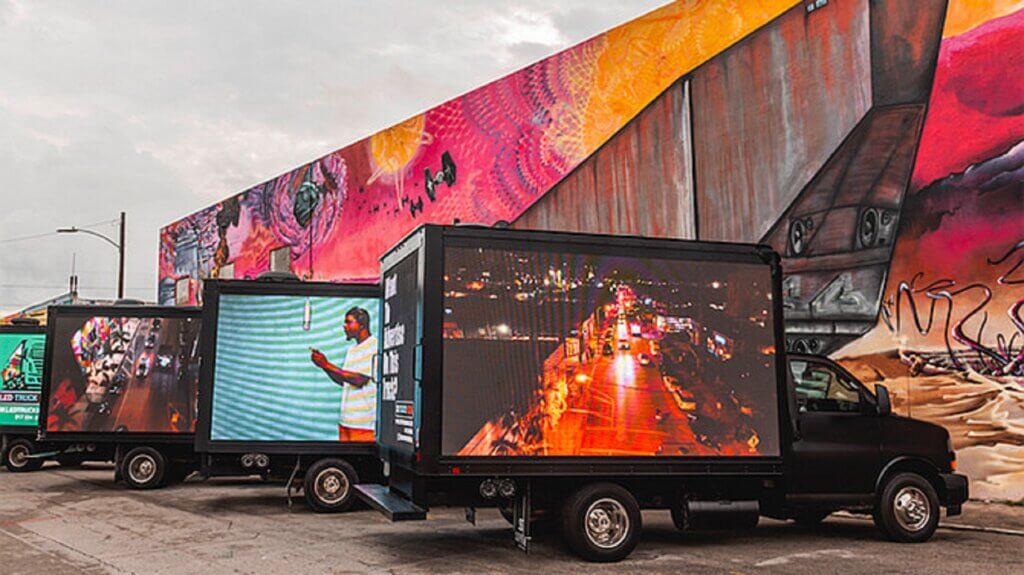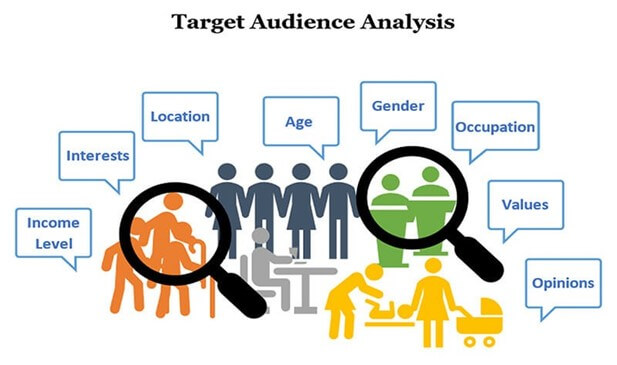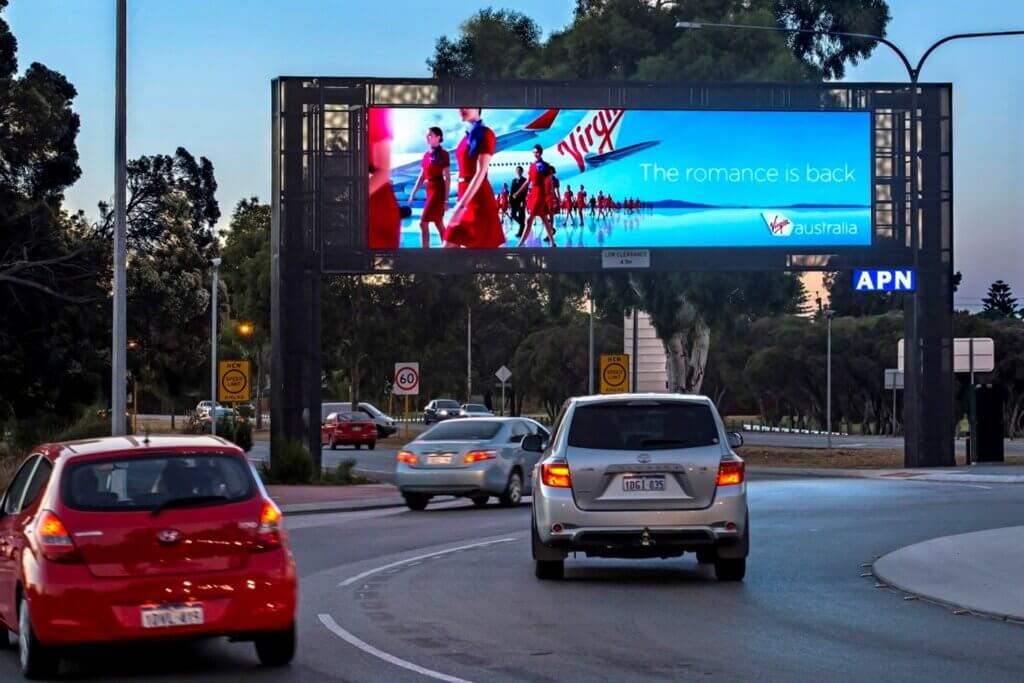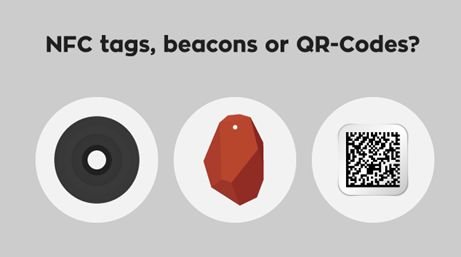
In the ever-evolving realm of advertising, where grabbing attention is paramount, mobile billboards have emerged as potent tools for connecting with diverse audiences. Beyond being mere vehicles, these rolling canvases represent dynamic platforms that take advertising directly to the streets. In
In this behind-the-scenes exploration, we uncover the intricacies of the meticulous planning and flawless execution essential to create impactful mobile billboard campaigns. Join us on a journey to understand how these mobile marvels navigate the urban landscape, turning heads and delivering messages in a way that transcends traditional advertising methods.
Planning Phase
- Research and Target Audience

In the dynamic world of marketing, the adage “If you target everyone, you don’t target anyone” highlights a common trap: businesses prioritizing sheer traffic over catering to a well-defined audience within their niche. This oversight can result in inefficiencies and missed opportunities. Recognizing the importance of a target audience is foundational for success in a competitive market. It transcends merely identifying potential customers; it involves acknowledging the diverse segments within the market and crafting strategies that resonate with each group.
The significance of a target audience becomes evident in its ability to enhance marketing clarity. In a highly differentiated marketplace, understanding the demographics of the audience to target is indispensable. A well-defined target audience provides clarity in engaging potential customers, making marketing initiatives more focused and effective. By zeroing in on the specific needs and preferences of a select group, businesses can craft messages that authentically resonate, thereby increasing the likelihood of consumer engagement and conversion.
Furthermore, a well-defined target audience facilitates strategic resource prioritization. When a business is crystal clear about its target audience, resource allocation becomes a strategic advantage. By identifying the segments of the audience most likely to purchase their product, businesses can allocate resources effectively. This approach prevents valuable resources from being scattered aimlessly, ensuring that marketing efforts are concentrated where they are most likely to yield fruitful results.
Understanding the dynamics of a target audience goes beyond demographic data; it involves grasping the psychographics, behaviors, and preferences that drive consumer decisions. This deeper understanding empowers businesses to tailor their products, messaging, and overall brand experience to align seamlessly with the identified audience, fostering long-term connections and success in a competitive market.
Understanding Demographics and Interests: A Blueprint for Mobile Billboard Design

With the foundation laid on the paramount importance of defining a target audience, the next crucial step in an effective marketing strategy is comprehending the intricate details of demographics and interests. It is not merely about recognizing potential consumers; it is about connecting with them on a profound level that resonates with their unique characteristics and preferences. In the realm of mobile billboards, this understanding becomes the guiding force behind both design aesthetics and messaging strategy.
What is demographic audience analysis?
Demographic audience analysis involves defining and scrutinizing an audience based on demographic factors such as age, location, gender, education, income, and other statistical data. This method allows for a comprehensive understanding of an audience’s expectations, the context influencing their purchasing decisions, and the cultural factors that demand consideration. Notably, it is one of the most accessible forms of audience analysis due to the readily available nature of this information.
Components of Demographic Data for Audience Analysis:
To comprehend how demographic analysis shapes the effectiveness of marketing initiatives, let’s explore key components of demographic data often considered in audience analysis.
- Age: The age range of a market segment provides insights into significant life events the audience may be undergoing, such as starting a family or planning for retirement. Age also reflects particular preferences and perceptions, guiding the selection of channels, platforms, websites, and publications to target.
- Geographic Location: Knowledge of an audience’s geographic location reveals a range of information, from cultural influences to weather patterns, offering valuable insights, particularly for retailers.
- Socioeconomic Status: Understanding the socioeconomic status of an audience aids in determining the appropriate price point to target and identifying product types likely to resonate with the given audience.
- Gender Identity: The gender identity of an audience unveils important cues about their needs and desires, influencing the demand for various product types beyond the obvious considerations.
- Industry: For B2B companies, awareness of the industry or industries within which an audience operates enhances the ability to address pain points, utilizing appropriate terminology and examples in marketing efforts.
While these represent just a fraction of the numerous components within audience demographics, this compilation emphasizes the substantial impact of having such information readily available when crafting a targeted and effective marketing campaign.
2. Budgeting and Logistics

Budgeting for a mobile billboard campaign involves a delicate balance. From securing permits to collaborating with transportation companies, every detail must align with the overarching financial plan. Logistics play a crucial role, determining optimal routes to maximize exposure. We explore the intricacies of budget allocation and the strategic decisions that go into the selection of routes, taking into account traffic patterns, events, and target hotspots.
- Define Objectives and Goals:
Clearly outline the campaign’s objectives and goals. Whether it’s brand awareness, product promotion, or event advertising, understanding the desired outcomes will guide budget allocations.
- Research Costs:
Conduct thorough research on the costs associated with a mobile billboard campaign. This includes expenses such as:
Mobile billboard rental: Obtain quotes from vendors, considering factors like vehicle type, size, and features.
Design and printing: Budget for the creation of visually appealing and impactful advertisements.
Technology enhancements: If incorporating LED screens, interactive elements, or other technological features, factor in the associated costs.
- Allocate Resources:
Based on the defined objectives and researched costs, allocate resources accordingly. Prioritize elements crucial to achieving campaign goals, ensuring a balanced distribution of the budget.
- Contingency Planning:
Include a contingency budget to account for unforeseen circumstances. This buffer allows for adjustments during the campaign without compromising its overall effectiveness.
- Assess Return on Investment (ROI):
Evaluate the potential ROI for each budgetary allocation. Determine which aspects are likely to yield the highest impact and contribute significantly to achieving the campaign’s objectives.
- Evaluate Cost-Efficiency:
Look for cost-effective options without compromising quality. Negotiate with vendors, explore bulk discounts, and seek ways to maximize value within the budget constraints.
- Monitor and Adjust:
Implement a system for monitoring budget expenditures in real-time. Regularly assess the campaign’s financial performance and be prepared to make adjustments to stay within budgetary limits.
2. Design and Creativity

Crafting a compelling mobile billboard design involves a meticulous process akin to creating effective static billboards. The creative journey starts by determining the type of mobile
Billboard aligning with campaign objectives and target audience engagement. Similar to directional billboards, mobile billboards can be strategically placed in high-traffic areas to maximize visibility.
Taking inspiration from traditional billboards, the design should harness simplicity and clarity. The use of catchy captions, simple colors, and ample white space ensures that the message remains legible, even at a glance. Additionally, incorporating high-quality and compelling images is pivotal, drawing on technology like AI for impactful visuals.
To further elevate brand identity, the integration of company logos and taglines echoes the strategy employed in static billboard designs. This consistency across various platforms reinforces brand recognition, a key element in effective mobile billboard advertising.
Considering the unique nature of mobile billboards, which are in constant motion, contrast and visual hierarchy become paramount. Utilizing contrasting colors and distinct shapes for text and images helps capture attention dynamically.
Just like in static billboards, a call to action takes center stage in mobile billboard designs. Whether urging viewers to visit a store, book now, or take a specific action, a well-placed and compelling call to action serves as the catalyst for audience engagement.
In summary, crafting a mobile billboard design follows the principles of static billboards but embraces dynamism. Defining the billboard type, integrating compelling visuals, and strategically placing calls to action aim to create a captivating and memorable advertisement, resonating with the mobile audience on the move.
Transition to Execution Phase: Bringing the Campaign to Life

With the creative blueprint of our mobile billboard design in hand, it’s time to delve into the dynamic execution phase. This pivotal stage involves critical decisions in vehicle selection, customization, and the implementation of comprehensive safety measures. Additionally, we’ll explore the role of technology in real-time monitoring, ensuring our campaign unfolds seamlessly on the streets.
Vehicle Selection and Customization: Navigating Impactful Impressions
The choice of vehicles is the dynamic canvas through which our message will traverse the urban landscape. Let’s dive into the meticulous considerations that guide our selection and the innovative customizations that will transform our fleet into attention-grabbing, mobile storytellers.
Size, Mobility, and Fuel Efficiency:
Our vehicle selection is a strategic dance between size, mobility, and fuel efficiency. Larger vehicles may dominate high-traffic areas, while nimble options navigate narrow streets.Prioritizing fuel efficiency not only aligns with eco-conscious values but also ensures our campaign goes the distance with minimal environmental impact.
Brand Alignment and Visibility:
Beyond logistics, the chosen vehicles are an extension of our brand identity. The design should harmonize with our message and capture attention effortlessly. Visibility is a non- negotiable factor, ensuring our mobile billboards command attention in the bustling urban environment.
Customization for Maximum Impact:
LED Screens:
The star of our customization is the installation of vibrant LED screens. These high-resolution displays turn our vehicles into captivating moving billboards. Videos and graphics come to life, making our message dynamic and unmissable. LED screens add a modern, tech-savvy edge to our campaign.
Audio Systems:
Sound amplifies the impact of our visual message. Our vehicles are equipped with carefully tailored audio systems that complement the campaign’s tone. Whether it’s a catchy jingle, a compelling voiceover, or synchronized music, the auditory element ensures our presence is not only seen but heard.
Interactive Elements:
To foster engagement, our customization includes interactive elements. QR codes, touch-sensitive displays, or augmented reality features invite the audience to actively participate. This hands-on approach transforms our mobile billboards into immersive experiences,leaving a lasting imprint on our audience.
Leveraging Technology for Real-time Monitoring in Billboard Campaigns
In the ever-evolving landscape of advertising, technology serves as a dynamic ally, extending its reach beyond online realms into the physical world. When it comes to out-of-home (OOH) advertising, particularly billboards, harnessing technology for real-time monitoring is not just a possibility but a strategic imperative.
Google Analytics Unveils Billboard Impact:
Just as Google Analytics is a staple for evaluating online advertising, its application extends to measuring the effectiveness of billboard campaigns. The power lies in comparing website performance before and after the introduction of billboards. Much like an A/B test, this analysis allows marketers to discern the specific impact of billboards on web traffic,engagement goals, and conversions.
Driving Traffic and Beyond:
The primary goal of many billboard campaigns is to drive online traffic, a feat that aligns seamlessly with the digital landscape. Cozy Earth’s success story, with a staggering 75% increase in brand search traffic attributed to billboards, showcases the tangible impact of merging physical and digital strategies.
Strategic Considerations for Accurate Measurement:
For the most accurate measurement, keeping campaign variables minimal is ideal. By focusing on web activity within the campaign geography and utilizing campaign-specific landing pages, marketers can attribute traffic effectively. Comparing data during the billboard campaign to a similar pre-campaign period ensures a fair assessment, with consistency in Google Analytics parameters.
Boosting SEO Through Billboard Impact:

Billboards, driving web traffic and increasing branded search volume, contribute to higher click-through rates (CTRs), a key factor in SEO algorithms. Aligning the out-of-home strategy with the online strategy creates a synergy that Google’s algorithms recognize, potentially boosting organic search rankings.
Impressions and Reach:
Technology plays a crucial role in defining the reach of billboard campaigns. Combining vehicular and pedestrian traffic data, along with demographic information, enables a nuanced understanding of weekly impressions. Impressions, while defining reach, also consider the frequency of ad exposure, ensuring a more accurate assessment of campaign impact.
From Branding to Action:
Billboard advertising, when executed memorably, extends beyond brand visibility to tangible action. Cozy Earth’s success emphasizes the importance of strong branding in prompting curiosity and sparking conversation. Billboards become not just static visuals but catalysts for increased branded search activity.
Flexing SEO Muscles with Keywords:
Beyond branded searches, billboards can indirectly influence SEO rankings through strategically chosen keywords. Aligning billboard content with high-value keywords and unique aspects of the business enhances the likelihood of improved search engine rankings. However, caution is advised to avoid unintentionally advertising for competitors.
In essence, technology acts as the bridge between the physical and digital realms,transforming billboards from traditional static displays to dynamic contributors to online success. Real-time monitoring, driven by tools like Google Analytics, not only measures impact but also informs strategic decisions for future campaigns. As billboards continue to evolve from mere visuals to interactive elements, the integration of technology ensures that their influence transcends the streets, leaving a lasting imprint in the digital landscape
Tools and Technologies Empowering Billboard Campaign Analysis

To ensure the effectiveness of a billboard campaign, advertisers leverage an array of innovative tools and technologies, delving into both quantitative metrics and qualitative insights. The following instrumental methods play a pivotal role in tracking a mobile billboard’s location, gauging engagement levels, and deciphering audience response:
1. GPS and Geolocation:
Equipping billboards with GPS technology becomes a strategic move. By tracking the movement of mobile devices in proximity, advertisers gain valuable insights into audience demographics. This not only estimates the viewership but also unravels audience travel patterns and dwell times, fostering data-driven decision-making and optimizing return on investment (ROI).
2. Bluetooth and Beacon Technology:
Bluetooth beacons strategically placed near billboards facilitate proximity-based engagement. Interacting with Bluetooth-enabled mobile devices, these beacons enable targeted marketing by sending ads or messages directly to users’ smartphones when their presence is detected. This personalized approach enhances interactivity and engagement, forging a deeper connection between the audience and the brand.
3.QR Codes and NFC Tags:
Incorporating QR codes or Near Field Communication (NFC) tags into billboard designs invites audience interaction. By scanning QR codes or engaging with NFC tags, potential customers are seamlessly directed to specific landing pages or apps. Advertisers can thereby track conversion rates and engagement levels, gaining valuable insights into the effectiveness of the campaign.
4. Audience Measurement Solutions:
Employing advanced analytics tools and platforms that amalgamate diverse data sources, including traffic data, mobile data, and demographic information, proves instrumental in obtaining comprehensive insights into the performance of billboard campaigns. These solutions go beyond mere impressions, providing a nuanced understanding of audience behavior and campaign effectiveness.
5. Social Media Listening:
Monitoring the social media landscape for mentions and trends related to billboard campaigns unveils qualitative insights into audience sentiment and engagement. This real-time feedback loop offers advertisers a pulse on the campaign’s viral potential, enabling them to adapt strategies based on audience reactions.
6. Surveys:
Supplementing social listening, surveys offer a direct avenue to track brand favorability and sentiment post-exposure to a billboard advertisement. By capturing both positive and negative comments associated with the campaign, surveys provide a more in-depth understanding of audience perceptions and preferences.
The evolving landscape of billboard advertising effectiveness hinges on the judicious integration of these tools and technologies. From precise geolocation tracking to real-time social media insights, advertisers today possess a multifaceted toolkit to assess and enhance the impact of their mobile billboard campaigns.
In conclusion, this in-depth exploration unveils the intricacies of planning and executing impactful mobile billboard campaigns. From the foundational importance of defining a target audience to the creative process of designing attention-grabbing visuals, and the dynamic execution phase involving vehicle selection and customization – every step is meticulously detailed.
The guide emphasizes the intersection of traditional and digital advertising through the integration of technology, particularly Google Analytics, in real-time monitoring. The tools and technologies discussed, from GPS and Bluetooth to QR codes and social media listening, empower advertisers to track locations, engage audiences, and obtain valuable insights for optimizing campaign effectiveness.
In essence, this mobile billboard mastery guide equips advertisers with a comprehensive toolkit to navigate the ever-evolving advertising landscape. By blending strategic planning, creative design, and cutting-edge technology, advertisers can now create campaigns that not only turn heads in the urban landscape but also leave a lasting impact in the digital realm.


